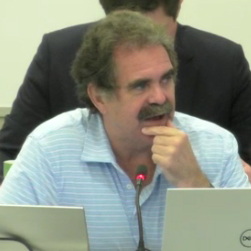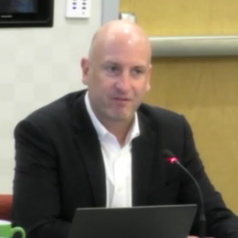Members Endorse Two Tier 1 Transmission Projects
ERCOT stakeholders endorsed two transmission projects with a combined capital cost of more than $760 million during last week’s Technical Advisory Committee meeting.
The Regional Planning Group classified both the Bearkat-North McCamey-Sand Lake project in West Texas and the Roanoke upgrade project north of the Dallas-Fort Worth area as Tier I projects because their costs exceed a $100 million threshold. Their status requires they receive TAC endorsement and the Board of Directors’ approval.
ERCOT staff said during the Wednesday meeting that it chose one of the first project’s three options to address reliability needs driven by rapid load growth in the Permian Basin’s Delaware Basin and to improve the region’s ability to import power. The recommended option will result in building two double-circuit, 345-kV transmission lines totaling about 165 miles, with the two segments meeting in McCamey, a former oil boomtown since labeled “the Wind Energy Capital of Texas” by the state legislature.
Bearkat-North McCamey-Sand Lake has a projected cost of $477.6 million in 2021 dollars, up from $371 million in 2019 dollars, and an estimated completion date of June 2026.
The Roanoke upgrade project involves 7 miles of 138-kV lines, 26 miles of 345-kV lines, four 345/138-kV transformers and five 138-kV low-voltage buses. Staff analyzed four options, choosing the one they say provides better operational flexibility and long-term load-serving capability for future load growth.
Oncor, the incumbent transmission service provider, expects to complete the upgrades by May 2025 at an estimated capital cost of $285.9 million.
The company has a hand in both projects. It paired with Lower Colorado River Authority Transmission Services and Wind Energy Transmission Texas to submit the first project to the RPG. It was alone in suggesting the upgrade project.
TAC approved the projects as part of its combination ballot, where they were included with unopposed revision requests and other measures. The board will consider both projects during its Aug. 16 meeting.
Staff Defer Comment on CSAPR
Staff told TAC they were unsure as to whether the Supreme Court’s recent decision voiding the Obama-era Clean Power Plan would affect a federal rule’s implementation that limits nitrogen oxide emissions. (See Supreme Court Rejects EPA Generation Shifting.)
Texas is one of more than 20 states that, under EPA’s Cross-State Air Pollution Rule (CSAPR) plan, must establish NOx emissions budgets beginning with the 2023 ozone season (May 1-Sept. 30). The agency says the reductions are necessary to address upwind states’ interstate transport obligations.
Staff were non-committal when asked whether the high court’s 6-3 decision in West Virginia vs. EPA would scuttle the CSAPR. The court rejected EPA’s assertion that “generation-shifting” was the “best system of emissions reductions” available and invoked the “major questions doctrine” that agency decisions involving “economic and political significance” require them to show “clear congressional authorization.”
Senior Corporate Counsel Katherine Gross noted that CSAPR was proposed under a different section of the Clean Air Act than was the CPP.
“At this point, we’re not sure of the significance of this case, and we don’t want to speculate too much about what it will mean for the ozone transport rule,” Gross said. “If the EPA rule here does have a significant economic impact, the EPA is going to need to be able to point to very clear congressional authorization, which they were not able to do in the Clean Power Plan rule, according to the court. And if they’re not able to do that, then that rule is going to be susceptible to being overturned.”
Gross said ERCOT would defer to the state’s Office of the Attorney General and the Public Utility Commission, both of which filed comments with EPA asking for the CSAPR rule’s withdrawal as it pertains to Texas (EPA-HQ-OAR-2021-0668-0007.)
The AG’s Office alleged the agency “acted arbitrarily and capriciously in several distinct ways, abused its discretion and failed to observe procedures required by law.”
“Regional actors are in the best position to determine how to meet the 2015 ozone transport obligations, but EPA failed to consult the necessary experts and denied states, specifically Texas, the opportunity to regulate where appropriate,” the office said.
The PUC said the transport implementation plan will have “significant, detrimental impacts on reliability” in the ERCOT region, as well as those portions of the state served by SPP and MISO.
ERCOT staff in June told the board that its preliminary analysis of the CSAPR rule assumed that over 10 GW of installed thermal generation would leave the market by 2026, requiring up to $1.5 billion to resolve local reliability issues. (See “10 GW Thermals Could Retire with EPA Rule,” ERCOT Board of Directors Briefs: June 21, 2022.)
Woody Rickerson, vice president of system planning and weatherization, told TAC that the thermal units staff “retired” in its analysis do not have the necessary emissions-reduction equipment and “seemed likely candidates” to be retired or retrofitted.
TAC Liaisons with R&M Trimmed
TAC Chair Clif Lange, with South Texas Electric Cooperative, told members that the committee’s leadership continues to work with several board members to iron out its reporting relationship under ERCOT’s new structure. (See ERCOT Technical Advisory Committee Briefs: June 27, 2022.)
He said TAC’s proposal to have as many as 11 liaisons with the board’s newly created Reliability and Markets Committee was found to be “cumbersome” and “unwieldy.” Lange said that in meeting with Directors Bob Flexon, the committee’s chair, and Peggy Heeg, they agreed that TAC’s chair and vice chair would act as liaisons. Segment representatives would be present should the R&M Committee want to hear from them.
Lange said the directors have additional changes they would like to see and they will continue to work with stakeholders on the details.
ERS Budget Increase Endorsed
The committee endorsed a Nodal Protocol revision request (NPRR1142) and its accompanying Other Binding Document revision request (OBDRR042) that had been granted urgent status by the Protocol Revision Subcommittee. The measure increases the annual budget for emergency response services (ERS) from $50 million to $75 million and gives ERCOT the ability to contract ERS for up to 24 hours in a standard contract term.
The NPRR is a result of a July PUC order that also allows the grid operator to broach the budget by up to $25 million for contract term renewals (53493).
 Clayton Greer, Morgan Stanley | © RTO Insider LLC
Clayton Greer, Morgan Stanley | © RTO Insider LLCMorgan Stanley’s Clayton Greer cast the lone opposing ballot in the 28-1 vote, saying he had requested information from ERCOT, still outstanding, on how many loads were already offline before ERCOT deployed them.
“We have waivers that allow loads to go offline when prices are high. We’re paying people to do what they would already do on their own,” he said. “There’s no additional value to this. I would rather see a capacity market where we pay all capacity that’s online.”
Staff said they wouldn’t have the data available until the end of August.
“We’re more than happy to bring this analysis to whatever stakeholder meeting would like to see it,” ERCOT’s Mark Patterson said.
RUC Scaling Factor to 100%
TAC members agreed with staff’s recommendation to change the reliability unit commitment’s (RUC) scaling factor from 20% to 100%, adding the measure to the combo ballot that passed unanimously.
ERCOT instituted a 20% scaling factor in 2018 with NPRR864, which modified the start-up and minimum energy costs for resources with a cold start time of one hour or less. This allowed the grid operator to defer commitment decisions and provide market participants additional time to self-commit their resources.
However, that has changed with ERCOT’s new conservative operations posture that makes greater use of the RUC process. Staff said the scaling has led to operators needing to make many of their RUC decisions outside of the process’s economic-based recommendations, leading to inefficient commitments.
Changing the cost-scaling factors to 100% will help ensure the commitment decisions better reflect the economically optimal commitment decision, ERCOT said.
“We’ve just seen more manual commitments occurring this year because of a desire to commit resources further in advance of the peak hours,” ERCOT’s Dave Maggio said.
The combination ballot also included six NPRRs, single changes to the Planning Guide (PGRR) and the Retail Market Guide (RMGRR), and a system change request (SCR):
-
- NPRR1085: improves the physical responsive capability calculation and dispatch’s validity by requiring quicker updates from qualified scheduling entities (QSEs) on telemetered resource status, high sustained limit and other relevant information.
- NPRR1133: clarifies the responsibilities of DC tie facility owners and operators for reporting DC tie model data.
- NPRR1134: removes references to first available switch date (FASD) after recent mass transition/provider of last resort events indicated ERCOT’s use of FASD when processing switch transactions created an unintended negative experience for customers being transitioned from a bankrupt retailer.
- NPRR1135: modifies the definition of real-time generation resources with an offline non-spin (OFFNS) schedule to allow non-zero values for the billing determinant only if the resource is offline when it telemetered OFFNS. This ensures an accurate settlement when an online resource erroneously telemeters OFFNS.
- NPRR1136: adds clarifying language to the logic in place as fast frequency response is developed to ensure a QSE does not replace a regulation service with fast-responding regulation service.
- NPRR1137: replaces the annual requirement to review the OBD list with a four-year review cycle.
- PGRR101: clarifies that a DC tie’s owner will provide the appropriate dynamic model data to its tie operator, which will then provide the data to ERCOT.
- RMGRR168: synchronizes ERCOT’s role and responsibilities with current market transactional solutions upon the removal of the “out-of-cycle” switch term and market process.
- SCR822: creates a new daily integration report and dashboard for energy storage resources similar to the current wind and solar integration reports and dashboards.


